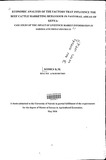| dc.description.abstract | The pastoral areas of Kenya comprise over 80 % of the country's land area. These areas are
inhabited by over 10 million people whose livelihoods mostly hinge on livestock. The area
hosts over 70 percent of the national cattle herd; with an annual slaughter of over 1.6 million
total livestock units. However, above 70 % of the population in these areas live below the
poverty line. Available literature has revealed little knowledge on the factors that influence
marketing behaviour of beef cattle producers in pastoral areas of Kenya. The purpose of this
study was to carry out economic analysis of the impact of livestock market information and
its influence on beef cattle marketing behaviour among other factors and to identify
important attributes used in beef cattle valuation by producers and how these attributes
affects price differential from the traders perspective.
The study employed a combination of purposive and random sampling in a survey of market
sheds in two districts of Kenya's rangelands, namely Garissa and Isiolo. This survey
generated primary data from 135 respondents. Secondary data was sourced from LINKS
website and statistical abstracts from Central Bureau of Statistic and FAO yearbook.
Regression methods of analysis usmg Nerlove Supply Response model (NSR) and the
Consumer Goods Characteristics Model (CGCM) were employed to explore the stated
objectives.
The study findings were: One, that beef cattle sector in Kenya has low response to price, this
response is negative for the current price and positive for one year lagged price. Two,
livestock market information does not influence beef cattle household off-take decision, these
decision are rather influenced by calving rate, purchase rate, off-pastoral income and
dependency ratio. And three, that animal attributes such as animal class, grade, sex, and other
variables like market location and volume were important determinants of beef cattle price.
These attributes show significant price differentials between each other and within each
other. The attributes were ranked as important by livestock producers when determining
which animal to sell.
From these findings, the following conclusions were drawn; firstly, that beef cattle sector in
Kenya has responded in an economical manner to changes in beef cattle prices. This response
was initially, in a perverse manner, explained by the treatment of cattle as capital goods and
eventually in a positive manner. Secondly, that livestock market information does not
influence producer off-take decision; a plausible explanation could be that pastoral
households based their decision on household needs which accounted for 91 % of the reasons
why households sell their livestock. This could also be attributed to the fact that disseminated
livestock information reached the isolated villages too late when it was no longer relevant or
accurate. Thirdly, that there was a well differentiated pricing system for beef cattle based on
animal attributes such as animal class, grade, sex and that these attributes are used both by
the livestock traders and producers in valuation.
The following recommendations are deduced from the study. One, that a framework for
reporting market information needs to be established to take into account the standardization
of reporting based on animal attributes. Secondly, on factors influencing beef cattle off-take,
the study proposes the improvement of breeds in order to minimize their calving intervals;
this should be coupled with investment in infrastructure, access to extension service
including veterinary services. Further, an expansion of source of income for pastoral
households will be achieved through increase investments in other sectors in pastoral areas.
In conclusion, the study extends analysis of the factors influencing beef cattle marketing
behaviour to variables hitherto unexplored in the literature. It uses market transactional data
to provide a body of empirical verifiable research results regarding attributes that are
important in beef cattle market information packaging. These findings provide important
insights into the ability of market information to accomplish its intended goal of enhancing
efficiency of livestock price discovery. An,d wealth of information to guide the policy maker
as regard interventions needed to spearhead development in the pastoral communities of
Kenya and beyond. | en |

